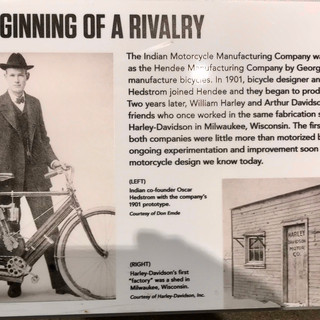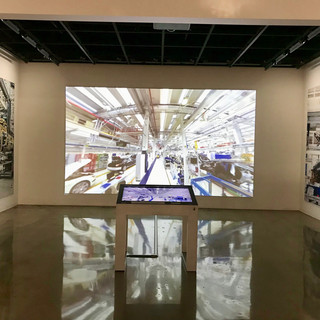TOUR - PETERSEN AUTOMOTIVE MUSEUM
- Ron Hadfield
- Jan 11, 2018
- 10 min read
"When a man opens a car door for his wife, it's either a new car of a new wife."
~ Prince Phillip
"The one thing that unites all human beings,
regardless of age, gender, religion or ethnic background,
is that we all believe we are above-average drivers."
~Dave Barry
One of my early ideas when I created my Updated Bucket List for Year 77 was to take the family and/or friends on a tour of several of the many unique and special attractions located in the Greater Los Angeles area. One such attraction is the Petersen Automotive Museum located in the downtown area of Los Angeles. Bonnie saw an article in the L.A. Times about a special attraction at the Museum showing the history and many bikes made by Harley-Davidson and Indian; this was enough motivation for me to schedule a visit.
Steve H. and Karan expressed an interest in touring the museum and we selected Wednesday January 10th as the day to do it. We met at Steve's house in Glendale, and drove to the museum. As we arrived at the museum I was a little taken back by the sight of the building; maybe even shocked. I guess I haven't adjusted to some of the contemporary architecture. As a little background, in 2015, the museum underwent an extensive $90 million renovation. The building’s facade was redesigned by the architectural firm Kohn Pedersen Fox, with the exterior featuring a stainless-steel ribbon assembly, made of 100 tons of 14-gauge type 304 steel in 308 sections and 25 supports. The remodeled museum opened to the public on December 7, 2015. My photo from a nearby corner is below.

There is a wonderful Italian restaurant, Drago Ristorante, on the main floor as you enter the museum and we had lunch there before beginning our tour.

Putting my final impression of the museum at the beginning rather than at the end, I believe anyone with the smallest interest in automobiles and their history would enjoy a visit to the Petersen Automotive Museum. The organization and presentation of the automobiles, and the signage, videos and other exhibits presented throughout, are very impressive -- very well-done.
The museum invites you to explore the history of the automobile and its impact on American life and culture through their diverse collection and exhibits. They have an Education Department that seeks to deepen that exploration and inspire learners of all ages and abilities by offering a wide range of educational programs and hands-on experiences, from school field trips, to lectures and classes for adults and children, to family events.
The museum features three themed floors. Visitors are encouraged to start their experience on the History floor (the 3rd floor) and work their way down through the Industry floor to the Artistry floor on the main level. The museum personnel feel that by experiencing the museum in this way, visitors are able to better appreciate the impact and application of the automobile.
=============================
The museum describes these floors as follows:

History: From the advent of the wheel through the industrial revolution, humans have focused enormous resources (brain power, man power, and money) on creating efficient modes of transportation.
The advent of the motor-car marks the moment when humans were freed from the restraints of centuries past. People and goods could move freely and independently, free of time-tables and limited only by connective infrastructure. As private ownership of automobiles rose from the 1910’s through the 1930’s, mobility meant prosperity and the pioneering spirit was reawakened.
By the 1960’s the automobile embodied attitude, style, and freedom — especially in California; and in Hollywood, the automobile became one of the world’s most treasured celebrities.

Industry: The advent of the internal combustion engine sparked many social, economic, political, and environmental benefits and curses. While the automobile assembly line and new technologies in materials and accessories helped fuel the demand for more cars, the environmental and economic problems that the automobile caused have had a lasting effect on the modern world.
Today’s creative designers, engineers, and social entrepreneurs are developing new automotive technologies that will ensure a more sustainable future at the same time automotive advances fuel growth in our globalized, high-tech economy. The personal stories of the inventors, mechanics, and drivers that have pushed the limits of automotive technology demonstrate tremendous courage, tenacity and opportunity in an ever burgeoning industry.

Artistry: Inspiration, emotion, exhilaration. These words are used by erudite art critics to describe fine works of art as often as they are used by creative ad agencies for automobiles. A beautiful automobile can lift your spirit, touch a memory, or ignite a fantastic daydream.
As an object the automobile represents a high functioning aesthetic born in science but connects to us all through the human experience. Like fine painting and sculpture, an automobile’s form can be universally grasped at the intersection of line, color and shape.
Add motion, sound and texture and the automobile becomes an immersive artistic experience akin to attending a musical or theatrical performance.
===================================
We followed the recommended approach and the three floors were very interesting and certainly worthwhile. The Museum owns approximately 300 cars and motorcycles, with the number of vehicles on display changing constantly. There are approximately 100 vehicles on the three general admission floors, another 100 in the Vault (available for private tours) and the remaining vehicles in many different places (such as at movie shoots, in restoration, etc.). Below are a few photos from each floor that I found the most interesting.

As we entered each floor there was a structure with the layout of that floor and a brief explanation of exhibits in each of the areas shown on the layout. You can see in the photos below that there are videos on many walls behind the autos and motorcycles, and other exhibits throughout the floor with interesting facts about a specific vehicle or with historical comments. The History Floor photos below from the left:
1st row - a 1957 Cadillac Eldorado Biarritz, with an interesting video playing in the background (this was one of my "favorites to have" as a junior in high school); next is a beautiful Duesenberg II SJ that appears to be of the early 1930s, but as described in the signage, was built in 1984 specifically for the movie "The Great Gatsby" (when the photos are enlarged you can read the plaque next to the auto).
2nd row - a 1915 Ford Model T Runabout, followed by a wall-sign summarizing some interesting facts about operating the Model T and explaining how Ford in 1919 added an "optional electric starter"; and finally a 1912 Indian Single.
3rd row - A 1904/05 FN Four Cylinder; next is an example of the historical comments that are written on the walls periodically - this one describes how the American film industry helped fuel the nation's passion for the automobile; and finally is a shot showing a row of cars down one wall and a motorcycle at the end. The car in the foreground is the 1981 DeLorean DMC 12 "Time Machine" used in the movie Back to the Future, and the third car (white) is a 1963 Volkswagen Beetle Herbie used in the TV series Herbie,The Love Bug.
Click Photo to Enlarge - Use Arrows for Next Photo
=======================

This structure was at the entrance to the second floor, the Industry Floor. There were many different exhibits on this floor, including an illustration of an automobile assembly line, discussion and exhibits about new technologies in materials, and even a group of hot rods, that Dale would have loved. This is the floor that included the special exhibit of Harley-Davidson vs. Indian which was my original motivation for visiting the museum. This exhibit details the founding of both Indian and Harley-Davidson in the early 1900s and the subsequent five-decade rivalry to become the world’s premier motorcycle manufacturer. Over a century after producing their first motorcycles, owners and enthusiasts continue to debate the merits of each manufacturer. The Industry Floor photos below from the left:
1st Row - At the entrance to the Harley-Davidson vs Indian exhibit was a signboard describing the beginning of the two companies - Indian in 1901 and Harley-Davidson a couple of years later. The first models from both companies were little more than motorized bicycles; the next two photos are Karan & Steve, then me, at the entrance to the exhibit.
2nd Row - A 1939 Harley-Davidson Model EL "Knucklehead" on the left, and a 1939 Indian Sport Scout on the right; next are two sidecar bikes - on the left is a 1922 Harley-Davidson FD with sidecar, on the right is the 1920 Indian Daytona Racer with Flexicar; the third photo shows the trikes of the early years - on the left is the 1962 Harley-Davidson Service Car, and on the right is the 1961 Indian Dispatch-Tow.
3rd Row - I remember Cushman motor scooters, but never Harley and Indian. The first photo shows on the top the 1963 Harley-Davidson Topper, and on the bottom the 1948 Indian Stylemaster; the second photo show two midget racers. In the early days these were typically built in private garages and workshops, using available parts, making each one unique. The racer on the left is a 3/4 midget racer powered by a Harley-Davidson engine, and the one on the right is a 1948 Drake 3/4 midget racer powered by an Indian engine; and the final photo is shown for the benefit of my grandson Griffin who knows every car from the movie Cars. I'm standing my Lighting McQueen.
Click Photo to Enlarge - Use Arrows for Next Photo
The exhibits shown below were also on the Industry Floor. Photos from the left:
1st Row - First is the Design Center located within the museum, and there was one individual inside working at his design table; next is what they call a "Buck" that is used to form the body of an automobile. This is a buck for a Bugatti Type 64; next is an ongoing movie showing an actual auto manufacturing production line.
2nd Row - Using photos, videos and actual automobile parts, these three exhibits show and explain the assembly of an automobile - first the body assembly, then interior assembly, and finally the finished product. Exhibits like this were very interesting and instructive.
Click Photo to Enlarge - Use Arrows for Next Photo
And finally, this floor included a number of hot rods and I've shown a couple below. The last photo is the under carriage of the orange car up on the hoist.

This structure was at the entrance to the first floor, the Artistry Floor. As I entered this floor I immediately had the impression that this was the "Bugatti Floor." This turned out to be the case. This is a description of how the museum views the Bugatti family:
For over 100 years, the extraordinarily gifted Bugatti family has produced art that the world has come to prize and celebrate. The range of their creativity is immense: drawing and painting, exquisite furniture design, jewelry and fine silver, musical instruments, literary pursuits, extraordinary bronze sculpture, and most well-known to the modern world, the design, engineering and fabrication of superb vehicles to satisfy man’s pursuit of freedom via transportation…at speed. This exhibition celebrates the best of their creations.
I only took photos of the cars (six photos of the 19 cars on display), but there was an impressive array of furniture, art, jewelry and musical instruments on display also. The photos below from the left:
1st Row - 1939/49 Bugatti Type 57C Atalante; 1930 Bugatti Type 46 Cabriolet; 1929 Bugatti Type 44 Fiacre.
2nd Row - 1951 Bugatti Type 101C; 1932 Bugatti Type 55 Super Sport; 1935 Bugatti Type 35 Ventorix.
Click Photo to Enlarge - Use Arrows for Next Photo
A Little History of the Museum - (Taken from the Museum website):
MISSION STATEMENT - To explore and present the history of the automobile and its impact on American life and culture using Los Angeles as a prime example.
ABOUT THE MUSEUM - Founded on June 11, 1994 by magazine publisher Robert E. Petersen, and his wife Margie, the Petersen Automotive Museum is owned and operated by the Petersen Automotive Museum Foundation. Previously located within the Natural History Museum of Los Angeles County, the museum is permanently housed in a historic department store originally designed by Welton Becket. The building opened in 1962 as a short-lived U.S. branch of Seibu Department Stores, before operating as an Ohrbach’s department store from 1965 to 1986. Six years after Ohrbach’s closed, Robert Petersen selected the largely windowless site as an ideal space for a museum, where artifacts could be displayed without harmful exposure to the ultraviolet radiation of direct sunlight. In 2015, the museum underwent an extensive $90 million renovation. The building’s facade was redesigned by the architectural firm Kohn Pedersen Fox, while designers at The Scenic Route configured interior spaces to accommodate changing exhibits that are intended to encourage repeated visits. The exterior features a stainless-steel ribbon assembly, made of 100 tons of 14-gauge type 304 steel in 308 sections, 25 supports and 140,000 custom stainless-steel screws. The remodeled museum opened to the public on December 7, 2015.
MUSEUM HISTORY - If there is one thing that we all have in common, especially in Southern California, it’s the automobile. To some the automobile is an appliance, but to us it is a passion. The Petersen Automotive Museum has been celebrating this passion since 1994 on the corner of Fairfax Avenue and Wilshire Boulevard, the third most traveled intersection in the city of Los Angeles. It anchors one end of the famed “Miracle Mile” created by real estate developer A.W. Ross in 1936. Created in a time before shopping malls, the Miracle Mile centralized shopping in the area and was “The” place to go for high-end shopping. Wilshire was also home to various “firsts” including dedicated left-turn lanes and the first timed traffic lights in the United States. Ross also required merchants to provide automobile parking lots behind their stores, all to aid traffic flow.The Museum’s unforgettable architecture by world renowned architect, Welton Becket was cutting edge when the building was opened in 1962 as Seibu, a Japanese department store. When Seibu left the United States in 1965, Ohrbach’s moved into the building and it became a popular local shopping spot until its closing in 1986. The building stood vacant for approximately 6 years until inspiration struck the late Robert E. Petersen, who was looking for a consolidated headquarters for Petersen Publishing. Upon further investigation, he decided that the near-windowless structure would not be the best choice for an office building, but it would make an excellent museum. To preserve the Museum’s artifacts inside, they need to keep away from the sun’s damaging ultraviolet rays. Seeing the building’s true potential as an automotive-inspired educational institution, Mr. and Mrs. Petersen put forth a large portion of the money necessary to create the Petersen Automotive Museum. The Museum was to be much more than a large room filled with cars parked in rows like an indoor parking lot. From the beginning, the vehicles chosen for exhibition had to be displayed in context to give them real meaning and a better experience for all who would come to visit. The “Streetscape” was full of architectural elements that were period correct for the vehicles that surrounded them, immersing visitors deep into the stories that were told. The second floor featured rotating exhibit areas and the third floor featured the Discovery Center which taught art and science through the automobile to children of all ages.The Museum was developed in a mere three years and opened on June 11th, 1994.



































































Comments